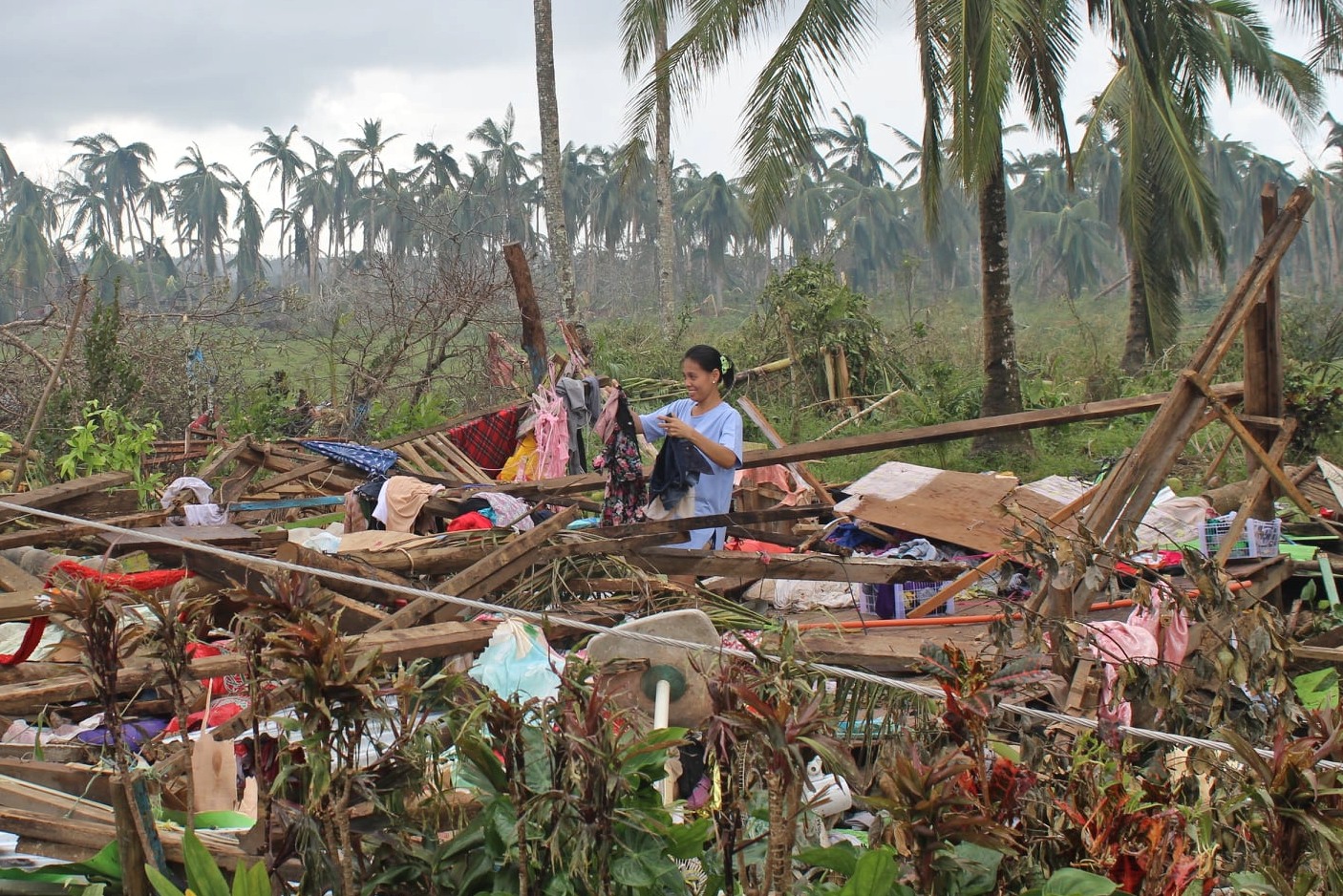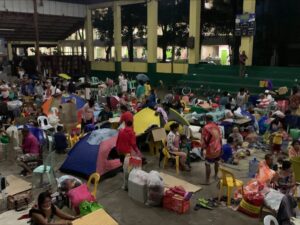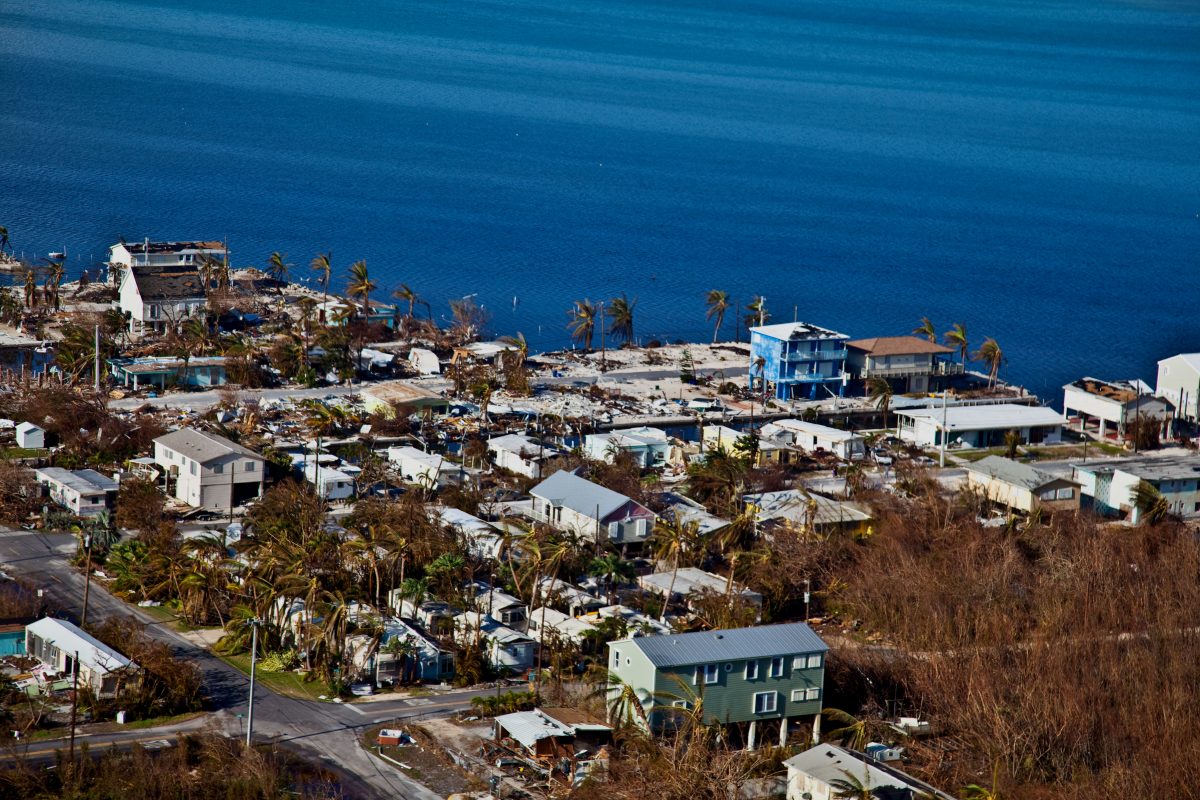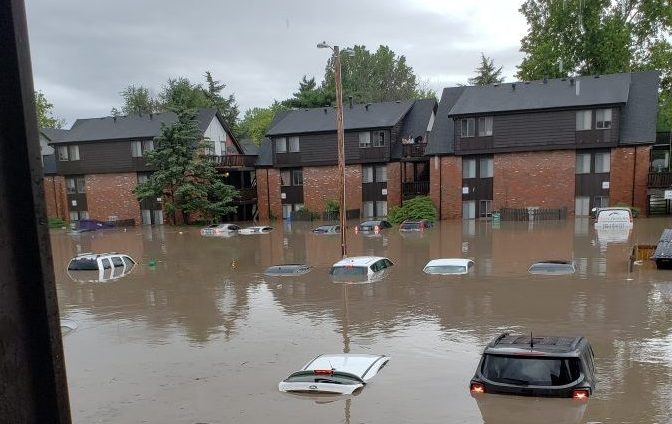

Super Typhoon Rai (known as “Odette” in the Philippines) was the 15th storm to hit the country in 2021 and was the strongest storm of 2021.
The typhoon made landfall on Thursday, Dec. 16 at 1:30 p.m. local time on Siargao Island in southeastern Philippines. Shortly after landfall with winds at 160 mph, it underwent an eyewall replacement cycle and decreased in strength to a Category 4, but winds remained at 150 mph. Rai/Odette made several other landfalls at Category 3 and 4 intensities throughout the day as it moved through the Philippines. At 3:10 p.m. local time on Friday, Dec. 17, the typhoon made its ninth landfall in Roxas, Palawan, before moving into the West Philippine Sea. Rai re-intensified to a Category 5 near Vietnam but weakened again and dissipated near Hong Kong on Dec. 22.
Odette/Rai strengthened from a Category 1 to 5 typhoon in just one day making it difficult for people to prepare for the arrival of the storm or to evacuate. The typhoon increased by 85 mph in just 24 hours. This rapid intensification of storms is becoming more common due to climate change. A similar process happened in the Gulf of Mexico in August with Hurricane Ida.
(Photo by the Bubong Municipal Disaster Risk Reduction and Management Office)
More than 300,000 people evacuated ahead of landfall and millions were affected. According to the National Disaster Risk Reduction and Management Council, more than 10,000 villages were in the path of the typhoon.
The 2021 Pacific typhoon season lasts throughout the whole year, but most tropical cyclones develop between May and October. In 2021, there were 42 depressions, 22 named storms, nine typhoons and five super typhoons (unofficial category used by the Joint Typhoon Warning Center for extremely strong typhoons). A super typhoon is equivalent of a Category 5 hurricane. Super Typhoon Rai (Odette) was the third Category 5 typhoon in South China Sea and the first Category 5 storm to develop in December since 2016. It was the third Category 5 storm to hit the Philippines in the past two years; the second in 2021.
Munich Re, a global reinsurer, listed Odetta/Rai as the second-deadliest natural disaster in its annual report on disaster impacts; the earthquake in Haiti was first. Aon PLC, a global risk management, insurance and reinsurance brokerage services provider rated it 5th overall, but the deadliest cyclone in 2021. Aon PLC included series of disasters – e.g., floods in India – as one disaster whereas Munich Re rated them separately.
Latest Updates

You, too, can help survivors of Super Typhoon Rai
What is the typhoon’s impact on communities?

As of Jan. 3, 2022, the chief of the national disaster agency reported 407 deaths, 78 people missing and nearly 1,150 people injured. Not all deaths, injuries or missing person reports have been validated so numbers are subject to change. In December, the chief stated that “damage to infrastructure and agriculture was estimated at 23.4 billion pesos ($459 million).”
The United Nations said that, “Latest assessments show that 11 out of the Philippines’ 17 regions were affected by the passage of Rai, which is known locally as Odette. It was the strongest typhoon to strike the Philippine archipelago in 2021 and disrupted the lives of more than seven million people, according to government data. In addition to flattening homes, the Super Typhoon upended lives and devastated farming and fishing communities which provide a major source of income and livelihoods. It caused massive electricity and telecommunications outages that continue to affect many areas.”
The UN’s Office for Coordination of Humanitarian Affairs (OCHA) provided a comparison on Jan. 11, 2022 of the differences between Typhoon Haiyan/Yolanda and Rai/Odette. It said, “Eight years after Super Typhoon Haiyan (known locally as Yolanda), the most destructive storm to hit the Philippines, Super Typhoon Rai (known locally as Odette) brought similar torrential rains, violent winds, mudslides, floods and storm surges to central parts of the Philippines, leaving a wide path of destruction and debris in its wake. While not as powerful as Haiyan, Rai damaged houses, infrastructure and livelihoods on a comparable scale. It struck as people across the Philippines were already coping with increasing poverty, unemployment and a roll-back on development gains following two years of the pandemic. Their resources are now depleted and local coping capacities are severely strained. One bright spot amid Rai’s destruction was the significantly lower number of casualties, which is thanks to pre-emptive measures undertaken by communities and Governments.”
Who is affected and in what ways?
OCHA reported that for Rai/Odette, as of Jan. 15, 2022:
- 8 million people were affected. “Southern Leyte was one of the worst-affected provinces, with 18 towns and cities suffering damage, and its capital Maasin city, utterly devastated. These areas desperately need more personnel and aid supplies.”
- 9 million people were displaced. 198,652 remain displaced across five regions as of Jan. 23, mostly in Southern Leyte, Cebu and Bohol. “Over 156,551 of these people are still in evacuation centres, mostly because their homes have been destroyed. Aid agencies are distributing shelter repair kits as quickly as possible to enable returns. Cash vouchers will also help families rebuild their homes. The Government has announced it will also provide $100 to each family with a damaged house.”
- 36 million homes were damaged (992,000) or destroyed (368,000) compared to 1.1 million for Haiyan
- 514 municipalities were affected. These “towns and cities suffered destruction including power outages, and damaged houses, roads, bridges, schools, health clinics, water and sanitation systems. One month on, 100 of these towns and cities still have power outages or no power at all. Restoring power is a priority, as 80 per cent of water systems cannot function without it, and relief efforts are having a difficult time responding without power or telecomms.”
As of Jan. 13, 2022, the World Food Programme (WFP) reported that 208,480 people were still displaced. They said the total crop area affected was more than 275,000 acres (111,500 hectares). WFP also stated that, “Alarming malnutrition rates pre-typhoon in some impacted areas could further deteriorate unless immediate food needs are met in the next six months. Assessments in affected provinces outside Caraga indicated market prices are still unstable, and food and cash are among top needs … the typhoon’s impact on malnutrition and health in the medium- long-term could be massive. In Caraga, before the typhoon hit, 53 percent of families were unable to afford a nutritious diet and childhood stunting was at 36 percent (indicating a “very high public health significance”). Amid the absence of clean water sources, cases of deaths due to diarrhoea have been reported in Caraga. Since the typhoon struck, there have been 895 cases and 9 deaths in Siargao Island and Dinagat Islands.”
Malaysia was also affected by the cyclone with 21,000 people evacuated or rescued and thousands more in need of assistance. Five people died in that country.
Immediate needs after a typhoon of this scale include emergency shelter, food, water, sanitation and hygiene, evacuation support, family reconnection, health care, protection of at-risk populations and case management. These needs will continue even as the recovery phase begins.
In addition to immediate response, long-term recovery needs include the rebuilding of homes and community infrastructure, restoration of electricity and water and sanitation systems, support for damaged businesses and agriculture.
Public health
Those affected by typhoons this year will need support to deal with the health impacts of ongoing and recurrent disasters in their country, combined with additional risks posed by COVID-19. As of Jan. 14, 2022, there were 3,129,512 cases of COVID-19 compared to 2,837,730 cases on Dec. 20, 2021 and just 470,000 in December 2020. Accompanying the COVID-19 challenges are the ongoing developmental challenges of lower-middle-income countries in the Asia-Pacific region. Several humanitarian responders have tested positive for COVID-19 limiting response activities.
Nutrition
Nutrition is also a critical component of recovery and public health. As mentioned previously, there are significant concerns about the costs of food and access to it for the population. The damage to agricultural lands also impacts nutritional outcomes.
WASH (Water, sanitation and hygiene)
Access to clean and safe water and sanitation is a critical issue immediately after a typhoon disaster and this exacerbates risk of COVID-19 and other water-borne and communicable diseases. “UNICEF is seriously concerned about the dire WASH situation in the typhoon-affected communities which could quickly lead to the further spread of diarrhoea and other WASH-related diseases, as well as the resurgence of COVID-19 infections. An estimated 2.3 million people need WASH assistance, while the WASH cluster will target 520,000 with emergency WASH services.”
Mental health
Mental health is also an area of immense need after any disaster but especially in contexts where disasters are frequent and extreme. Although the path of Haiyan and Rai were different, the emotional impact of a second major typhoon will likely trigger grief and mental health challenges. The loss of life and home are major traumas for survivors.
Island recovery
Recovery on an island or chain of islands presents particular challenges. Lack of access when ports, ferry docks and runways are destroyed and communication challenges when power, information and telecommunication infrastructure is destroyed means relief and recovery efforts are slowed. Access to clean and safe water and adequate sanitation are a critical issues immediately after a typhoon and are especially challenging in an island environment. The slow pace of recovery means some families end up resettling in a new community and do not return home.
Economic recovery and housing
Across the affected areas, the loss of housing, community infrastructure and commercial/retail spaces is significant and the extent of the damage will prove challenging and create barriers to recovery. In many rural communities, housing conditions were often poor before the storm, and loss of housing will lead to increased overcrowding in shared and communal shelters, which can also adversely affect health, particularly with the increased risk of COVID-19 transmission.
Education
12 million children had their schooling interrupted across nearly 30,000 schools. At least 2,000 schools – 4,200 classrooms – were damaged. Temporary learning spaces were created and learning kits distributed in various communities and islands.

CDP’s Global Recovery Fund (select 2021 Super Typhoon Rai/Odette) provides donors with opportunities to meet the ongoing and ever-expanding challenges presented by global crises.
Contact CDP
Philanthropic contributions
If you would like to make a donation to the CDP Global Recovery Fund, please contact development.
Recovery updates
If you are a responding NGO or a donor, please send updates on how you are working on recovery from this disaster to Tanya Gulliver-Garcia.
We welcome the republication of our content. Please credit the Center for Disaster Philanthropy.
Donor recommendations
If you are a donor looking for recommendations on how to help with disaster recovery, please email Regine A. Webster.
Philanthropic and government support
Even though $56 million USD (2 billion pesos) has been promised by outgoing Philippine President Rodrigo Duterte a great deal more will be needed, especially for long-term recovery.
CDP awarded a $165,000 grant to Relief International (U.K.) for flexible cash assistance to meet immediate needs, livelihoods training and support and hygiene awareness to combat COVID-19. Through this project, 1,150 of the most affected households will have improved abilities to recover quickly from the typhoon.
CDP also awarded a $98,872 grant to Philippine Disaster Resilience Foundation, Inc.. to help communities restore their livelihoods and provide training on boat building to fishing communities in Siargao and Dinagat Islands.
The government-run Philippine Amusement and Gaming Corporation sent 9,000 relief packs, as well as other non-food items, to several communities and plans to send an additional 8,000 relief packs. This was supported by local casino operators. An additional $975,000 (PHP 50 million) was used to purchase relief goods for citizens of Visayas and Mindando regions by Solaire Resorts’ Bloomberry Cultural Foundation Inc. (BCF). Additionally, BCF employees distributed relief packs on Siargao Island and will be volunteering in additional communities soon.
The United Nations launched a $107.2 million appeal with $25 million requested as part of the total from the World Food Programme to support food, logistics and telecommunications support. As of Jan. 17, 2022, 45% of the needed funds had been pledged to support the Humanitarian Needs and Priorities.
UNICEF also made an appeal, “for US$11.48 million to reach at least 200,000 children and their families who are most affected. Almost one month into the emergency, UNICEF has received US$4.4 million (38%), leaving a funding gap of US$7 million (62%).”
OCHA also reported that as of Jan. 21 there were 69 organizations and 145 partners providing services to help with recovery. They were providing support in 17 different clusters including WASH, health, shelter and protection.
The Government of Japan provided $13 million in assistance on Jan. 14, 2022, disbursed as follows:
- “World Food Programme (WFP): Food, Nutrition, Logistics [USD 5 million]
- International Organization for Migration (IOM): Shelter, Health, Camp Coordination & Camp Management [USD 4.2 million]
- International Federation of Red Cross and Red Crescent Societies (IFRC): Shelter/Non-Food Items, Food, Water/Sanitation/Hygiene (WASH), Health [USD 1.83 million]
- United Nations Children’s Fund (UNICEF): WASH [USD 1.6 million]
- United Nations Office for the Coordination of Humanitarian Affairs (OCHA): Inter-agency Coordination [USD 0.2 million]
- Office of the United Nations High Commissioner for Refugees (UNHCR): Shelter/Non-Food Items, Protection [USD 0.17 million].”
As with most disasters, cash donations are recommended by disaster experts as they allow for on-the-ground agencies to direct funds to the greatest area of need, support economic recovery and ensure donation management does not detract from disaster recovery needs. The government of the Philippines is seeking both cash and arranged/supported in-kind donations for the following items: food supplies, hygiene items, shelter materials, water and shelter repair materials.
Related resources

Hurricanes, Typhoons and Cyclones
Hurricanes, also called typhoons or cyclones, bring a triple threat: high winds, floods and possible tornadoes. But there’s another “triple” in play: they’re getting stronger, affecting larger stretches of coastline and more Americans are moving into hurricane-prone areas.

Floods
Flooding is our nation’s most common natural disaster. Regardless of whether a lake, river or ocean is actually in view, everyone is at some risk of flooding. Flash floods, tropical storms, increased urbanization and the failing of infrastructure such as dams and levees all play a part — and cause millions (sometimes billions) of dollars in damage across the U.S. each year.

Landslides
Landslides are a movement of a mass of rock, debris or earth down a slope. Landslides are a type of ‘mass wasting,’ which denotes any down-slope movement of soil and rock under the direct influence of gravity.